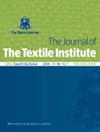Dyeing performance on polyester fibers and DFT investigation of newly synthesized 2-arylazo-dioxoisoindolinecyanoacetamide derivatives
IF 1.5
4区 工程技术
Q2 MATERIALS SCIENCE, TEXTILES
引用次数: 0
Abstract
AbstractA series of aryl-diazinyl-cyanoacetamide (2a–l) were prepared by coupling the appropriate diazotized arylamines with dioxoisoindoline cyanaoacetamide (1). Also, the cyclization of azo derivatives (2f, 2h, and 2j) with chloroacetonitrile to yield the pyrazole derivatives (5f, 5h, and 5j) was studied. Moreover, compound 2d reacts with malononitrile to afford compound (6e). In a similar manner compound, 2d reacts with hydroxylamine to afford the sole product tetrazine derivative 8d. All the newly synthesized compounds were fully characterized by both analytical and spectral analyses. The geometries of the azo and hydrazo tautomeric forms were optimized at the B3LYP/6-311G level of theory. The dyeing performance of the synthesized dyes on polyester fibers has been assessed. Most of the dyes showed a good affinity to polyester fibers. No details regarding the synthesis and dyeing performance of such dyes are reported before in the literature.Keywords: Azo disperse dyespolyester fiberscyanoacetamidedyeingdyeing performance Disclosure statementNo potential conflict of interest was reported by the authors.新合成的2-芳基偶氮-二氧异吲哚-异氰乙酰胺衍生物在聚酯纤维上的染色性能及DFT研究
摘要:通过适当的重氮化芳胺与二氧异吲哚氰乙酰胺偶联,制备了一系列芳基二嗪基氰乙酰胺(2a - 1)。并研究了偶氮衍生物(2f、2h和2j)与氯乙腈的环化反应,得到吡唑衍生物(5f、5h和5j)。此外,化合物2d与丙二腈反应生成化合物(6e)。以类似的方式,2d与羟胺反应得到唯一产物四嗪衍生物8d。所有新合成的化合物都通过分析和光谱分析得到了充分的表征。在B3LYP/6-311G理论水平上对偶氮和腙互变异构体的几何形状进行了优化。对合成染料在聚酯纤维上的染色性能进行了评价。大多数染料对聚酯纤维具有良好的亲和性。关于这类染料的合成和染色性能,文献中没有详细的报道。关键词:偶氮分散染料聚酯纤维氨基乙酰胺染色染色性能披露声明作者未报告潜在利益冲突。
本文章由计算机程序翻译,如有差异,请以英文原文为准。
求助全文
约1分钟内获得全文
求助全文
来源期刊

Journal of the Textile Institute
工程技术-材料科学:纺织
CiteScore
4.20
自引率
5.90%
发文量
149
审稿时长
1.0 months
期刊介绍:
The Journal of The Textile Institute welcomes papers concerning research and innovation, reflecting the professional interests of the Textile Institute in science, engineering, economics, management and design related to the textile industry and the use of fibres in consumer and engineering applications. Papers may encompass anything in the range of textile activities, from fibre production through textile processes and machines, to the design, marketing and use of products. Papers may also report fundamental theoretical or experimental investigations, including materials science topics in nanotechnology and smart materials, practical or commercial industrial studies and may relate to technical, economic, aesthetic, social or historical aspects of textiles and the textile industry.
All published research articles in The Journal of The Textile Institute have undergone rigorous peer review, based on initial editor screening and anonymized refereeing by two expert referees.
 求助内容:
求助内容: 应助结果提醒方式:
应助结果提醒方式:


